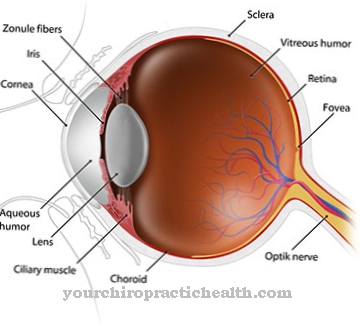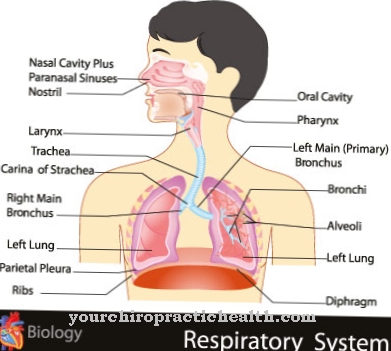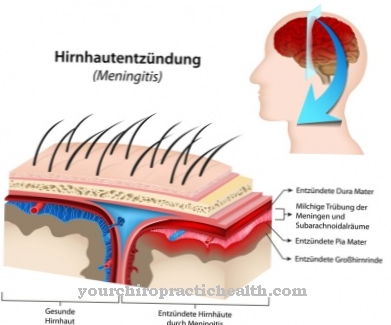Dupuytren's disease or Dupuytren's contracture describes a disease in which there are changes in the connective tissue of the hands. The fingers curve more and more in the direction of the palm. As a result, those affected can no longer use their hands properly and experience significant restrictions in their everyday life.
What is Dupuytren's disease?
.jpg)
© Ella - stock.adobe.com
Under Dupuytren's disease Doctors understand a pathological change in the connective tissue plate in the hand. Basically, the healthy connective tissue has a rather fibrous structure at this point. The disease hardens it, however, and strands and nodules form, which on the one hand harden the finger tendons and on the other hand shrink the tissue of the hand.
As a result, single or multiple fingers bend towards the palm and can ultimately no longer be stretched. Pain usually does not occur with Dupuytren's disease; however, the hands of those affected are markedly motor impaired, especially in the later course of the disease.
The disease often affects both hands equally. Dupuytren's disease usually occurs between the ages of 40 and 60, with men falling ill more often than women. According to statistics, around 1.3 to 1.9 million people in Germany suffer from Dupuytren's disease.
causes
The causes for Dupuytren's disease have only recently been known. The fact that the disease occurs more frequently in some families has long indicated that a genetic predisposition could be decisive for the tissue change.
Recent research has shown that the disease is caused by a genetic change. The regions of the genes that are responsible for signal transmission in cells are particularly affected. If certain signal pathways are disrupted, the connective tissue cells are converted into another cell type, which is responsible for wound healing and forms collagen, among other things.
This is deposited on the flexor tendons of the fingers and thus ensures permanent hardening. Dupuytren's disease occurs slowly and in episodes, which makes it difficult to detect the disease early. In the long run, however, there are significant restrictions on the movement of the fingers. Doctors divide the course of the disease into different stages. Finger extension can be impaired as the disease progresses between 0 and 135 degrees.
Symptoms, ailments & signs
Dupuytren's disease manifests itself in the beginning by a nodular thickening at the base joint of the little or ring finger. Due to an overgrowth of the connective tissue tendon plate on the palm of the hand, the affected fingers are increasingly drawn in. Men suffer from this benign tumor much more often than women.
At first this is not painful, at most uncomfortable. And it makes stretching your fingers difficult. As the process progresses, it becomes more and more difficult to open the fingers as the tissue becomes increasingly short and hard. In the palm of the hand, noticeably thickened strands can be felt instead of knots.
Joint capsules that are indirectly affected also shorten due to the lack of extension. Blood vessels and nerves are hindered in their function by the constant flexing of the fingers. In rare cases there may be pain. These usually occur when a nerve is trapped in one of the connective tissue nodes.
If the contracture remains untreated over a long period of time, the affected fingers can be drawn in until they touch the palm and can no longer be stretched. This leads to a considerable impairment in everyday activities, since the hand can no longer fulfill its gripping function to the full extent.
Diagnosis & course
If you suspect Dupuytren's disease, you should first see your doctor. This first examines the hand optically and feels the symptoms. Furthermore, the doctor will rule out other illnesses, such as joint wear and tear. An X-ray examination can also be used for diagnosis.
The course of the disease is mostly insidious. At the beginning there are hardly any significant complaints to be noticed. Over time, however, the mobility of the fingers decreases significantly. In addition, both hands are often affected. If left untreated, the fingers or the hand can no longer be stretched and remain in a constantly curved position.
Complications
Dupuytren's disease causes various complaints and restrictions on the hands of the patient. In most cases, the fingers are bent, so that those affected are severely restricted in their everyday life. Ordinary activities can then no longer be carried out without further ado. Sometimes patients need help from other people.
The quality of life is significantly reduced by Dupuytren's disease. Psychological complaints and depression can also occur due to the restrictions. The fingers are usually immobile and can also be affected by scars. Self-healing does not occur with this disease, so that a doctor must be consulted in any case.
In most cases, Dupuytren's disease requires surgery to resolve the symptoms. There are no complications. In many cases, however, the mobility of the fingers can only be restored temporarily, so that new interventions are necessary. Radiation therapy can also treat the symptoms and lead to a positive course of the disease. Life expectancy is usually not influenced or reduced by Dupuytren's disease.
When should you go to the doctor?
If Dupuytren's disease has developed as a result of a benign growth, those affected go to the doctor by themselves because they cannot stretch their fingers.
However, it can take years for the flexion contracture of Dupuytren's disease to develop fully. With the initial symptoms, those affected usually do not go to the doctor. Many treat the noticeable hardening of the palm of the hand with massages or ointments. Both hands are often affected by Dupuytren's disease. Usually only certain fingers are restricted in movement. This, too, often prevents a doctor's visit. Sufferers learn to use their hands differently. Many adapt to their mobility restrictions.
However, it is advisable to see a doctor early if you have problems with your hands, as this can rule out other diseases. There is a choice of therapeutic measures, exercise training or surgical interventions. Often no treatment is needed at all. Sometimes a needle fasciotomy or radiation can be used for relief.
Treatment & Therapy
It comes as part of a Dupuytren's disease-If the fingers are restricted in movement by more than 30 degrees, surgery is generally performed. This can temporarily restore the mobility of the fingers. Different surgical methods are used. For example, the hardened tendons can be severed or the entire connective tissue plate removed from the hand.
Experience shows that surgery will last longer when more tissue is removed. Often, however, the mobility of the fingers cannot be maintained permanently. Relapses occur relatively often, so that further interventions may be necessary. This is especially the case if the family has already had the disease several times. In addition to surgical therapy, other treatment methods can also be used for Dupuytren's disease.
The doctor treating you can inject an enzyme into the affected area, which dissolves the collagen and thus the hardening. If the disease is detected at an early stage, X-rays (radiation therapy) can also be used. These prevent the cells that form nodules from multiplying. However, this treatment method for Dupuytren's disease can only be used if the disease is in its early stages. At a later point in time, X-rays remain ineffective.
Outlook & forecast
Dupuytren's disease is an incurable disease. Thanks to extensive therapeutic measures, the prognosis is very good. Many patients do not develop contractures or other symptoms. It is enough to monitor the course of the disease and treat mild ailments with medication. The affected hand can be treated surgically.
During the procedure, the diseased connective tissue is completely removed, allowing the tendons to move freely. The quality of life can be significantly improved by such an intervention. This also increases well-being, as the patient may be able to continue doing his previous job and no longer need the help of other people.
With early treatment, the prognosis is significantly better than with late-stage treatment, when the curvature of the fingers is already well advanced. Life expectancy is not reduced by Dupuytren's disease. The recurrence rate, i.e. the probability that the disease will recur within five years, is up to 40 percent. The prognosis is made by the responsible specialist with regard to the condition of the fingers and tendons and the previous course of the disease.
prevention
As it is at Dupuytren's disease If it is a genetically determined disease, prevention in the strict sense is not possible. Anyone who sees signs that could point to Dupuytren's disease should, however, consult a doctor as soon as possible and have the cause of the symptoms clarified. If Dupuytren's disease is actually involved, the chances of successful therapy are significantly greater if it is started early. The disease is not curable; however, the symptoms can be significantly alleviated and the course slowed down.
Aftercare
Follow-up care after surgery for the treatment of Dupuytren's disease is considered extremely important. It can be carried out in an inpatient or outpatient setting. The patient's cooperation plays an important role in this. The first follow-up treatment starts immediately after the operation. With the help of a plaster splint, the operated hand can be immobilized for a week.
However, the fingers must be able to be moved in all joints. After the plaster cast, the patient is usually given a compression bandage. This counteracts the formation of swelling after the surgical procedure and at the same time ensures freedom of movement for the fingers.
The sutures are pulled around 14 days after the operation. It will take until the third week before the bandage can be removed. The patient then has the task of moving his fingers as independently as possible and without stress. If he works well and follows the doctor's instructions, he usually does not need any physiotherapy treatment. If swelling occurs, it can be treated with lymphatic drainage.
In order not to overwhelm the treated hand, it is gradually brought back to everyday stress over a period of six weeks. The patient must avoid heavy hand strain for about 12 weeks, at the same time he should take advantage of occupational therapy exercises to encourage the mobility of the finger. Regular supply of the scar tissue with a fatty cream has proven to be a helpful measure.
You can do that yourself
In Dupuytren's disease, the person affected can counteract the shortening of the connective tissue. Daily and consistent practice is important. The two options for self-treatment include stretching the affected tissue and strengthening the extensor fingers.
The self-stretching of the palmar aponeurosis (connective tissue plate of the palm) can be preceded by a gentle massage. Any massage oil is just as suitable as a drop of vegetable oil from the kitchen. With the thumb of the healthy hand, the palm of the affected hand can be stroked along the metacarpal bone from the ring and little fingers towards the fingertips and massaged in a circle. Then the curved fingers are gently stretched and thus straightened. These exercises can be used in the bathtub, as the warm water promotes relaxation and facilitates self-stretching.
After the stretch, the fingers are actively stretched. The hand lies with the palm on a table top. Each finger is first lifted and held individually from the surface. In the end, all fingers are lifted at the same time. The fingers should always be spread apart. To increase the resistance for the muscles, a rubber band can be stretched over all fingers. The victim now tries to spread his fingers against the ligament.




.jpg)
.jpg)
.jpg)

















.jpg)



